The Long Blue Line blog series has been publishing Coast Guard history essays for over 15 years. To access hundreds of these service stories, visit the Coast Guard Historian’s Office’s Long Blue Line online archives, located here: THE LONG BLUE LINE (uscg.mil)
Editor’s note: This essay first appeared in the pages of Sea History (Spring 2022) and is reprised courtesy of that magazine.
As with so many forgotten Coast Guard stories of heroism, bravery and courage, the compelling saga of Michael Augustine Healy and his trusty cutter Bear is unknown to most Americans. While only one of the Bear’s 27 captains during its 89 years of meritorious service, ‘Roaring Mike’ Healy served as Captain of the Bear from 1886-1895, and his legacy is most closely tied to the Bear’s. Many of the other captains and officers who served on the Bear have become iconic names in U.S. Coast Guard history … Tuttle, Jarvis, Bertholf … but Healy is by far the most famous.
Healy was born in 1839 on a plantation in Georgia to a plantation owner and a slave. His father sent Healy north with his siblings so they would escape enslavement in the South and attend what was, at the time, the Holy Cross Boys Academy in Worcester, Massachusetts. During his lifetime, he never self-identified as African American, presumably to conceal his true identity to avoid potential issues, at that time, with career-advancement in his chosen profession. His father’s foresight and love for his children gave them the opportunity to escape enslavement, avoid discrimination, and lead productive and successful lives in New England. Although his career achievements were extraordinary, and his racial identity was never formally questioned during his career, he was a troubled man. He was an alcoholic, at one point being court-martialed, lost his command of the Bear and was thought to be afflicted with bouts of deep depression and anxiety. Forced to live this double life, Mike Healy may have escaped the horrors of slavery, but could never truly escape his heritage.
Healy’s calling was the sea. He enlisted from Boston and received his commission from President Abraham Lincoln in 1865, just a month before Lincoln’s assassination. As such, Healy is now considered the nation’s first African American commissioned officer; first African American officer to command a U.S. vessel of any kind; first African American to achieve every commissioned officer rank from 3rd lieutenant to senior captain (a rank at the time equivalent to today’s flag rank); and first African American officer to sail the Bering Sea and the Arctic.
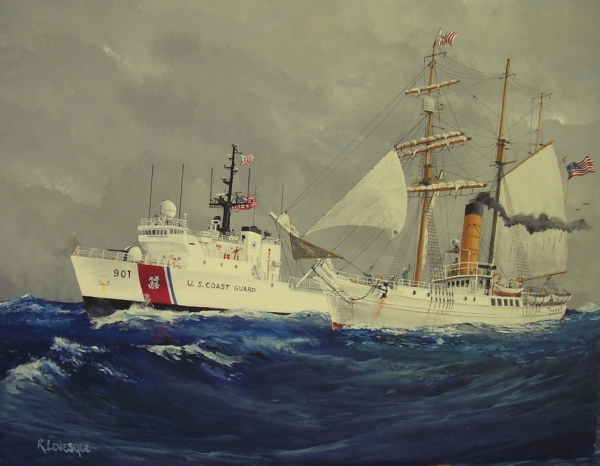 Many may have heard of the sheriffs and marshals of the Old West. Men such as Wyatt Earp upheld the law in places like Tombstone, Arizona. While law enforcement officials of the Old West laid down the law in a town or stretch of land, Captain Healy laid down the law for the Territory of Alaska and the Bering Sea, an expanse of water and land roughly the size of the lower 48 states. Moreover, while sheriffs in the Old West used a horse and gun for law enforcement, Healy commanded an armed U.S. ship, the Bear, which cruised between 20,000 and 30,000 miles in its annual Bering Sea Patrols.
Many may have heard of the sheriffs and marshals of the Old West. Men such as Wyatt Earp upheld the law in places like Tombstone, Arizona. While law enforcement officials of the Old West laid down the law in a town or stretch of land, Captain Healy laid down the law for the Territory of Alaska and the Bering Sea, an expanse of water and land roughly the size of the lower 48 states. Moreover, while sheriffs in the Old West used a horse and gun for law enforcement, Healy commanded an armed U.S. ship, the Bear, which cruised between 20,000 and 30,000 miles in its annual Bering Sea Patrols.
Moreover, few know of Alaska’s far more dangerous maritime frontier of the late 1800s. There, Healy made his name contending not only with misfits and criminals, but deadly sub-zero temperatures and ship-sinking ice with a wooden ship and ice resistant technology far less capable than today’s.
Built in 1874 as a steam and sail powered Arctic sealer, Cutter Bear had wooden walls as thick as the USS Constitution’s and an iron bow to find its way through leads in pack ice. During Bear’s 40-year career in Alaska, the cutter performed some of the most daring and successful Artic rescues in history. When malnourished Native Alaskans needed food, Bear brought it; when stranded whalers needed rescue, Bear saved them; 100 years ago, when thousands of Alaskans contracted the Spanish Flu, Bear brought doctors and medicines; when coastal settlements needed mail from the outside world, Bear delivered it; and, when mutinies broke out on Bering Sea ships, Bear quelled the outbreaks.
Bear was retired from Alaskan service after a meritorious 40-year career. By that time, she had sailed over one million miles in Alaskan waters, but her career was far from over. In the 1920s and 1930s, Bear became the command ship for polar explorer Richard Byrd’s expeditions to the South Pole, establishing the U.S. base at Little America. Finally, in World War II, at well over 60 years of age, Bear was commissioned a U.S. Navy vessel for service in the Greenland Patrols and helped seize the first enemy vessel of the war.
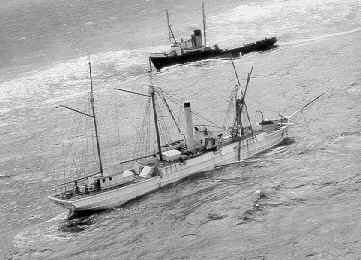 After the war, Bear was decommissioned, sold to a steamship company in Nova Scotia, and remained there until 1963, when she was towed to Philadelphia to serve as a waterfront restaurant and maritime museum. During the transit, the ship and tow encountered heavy seas, causing the old wooden vessel’s plank seams to open to the sea. She slowly sank below the waves.
After the war, Bear was decommissioned, sold to a steamship company in Nova Scotia, and remained there until 1963, when she was towed to Philadelphia to serve as a waterfront restaurant and maritime museum. During the transit, the ship and tow encountered heavy seas, causing the old wooden vessel’s plank seams to open to the sea. She slowly sank below the waves.
Bear had served in various capacities for nearly 90 years, a remarkable record for a ship built of wood. During her career, Bear had explored, policed, protected, nurtured, defended, and helped preserve the Polar Regions and the humans and animals that survive in those forbidding lands.
However, Bear’s story did not end with Bear’s loss in 1963. Instead, a new chapter in the Bear story opened when the search for the historic ship began. In 1979, Massachusetts Institute of Technology’s Dr. Harold Edgerton, inventor of side-scan sonar, launched a search for the Bear near the cutter’s last known coordinates before she left the surface. Edgerton was unsuccessful in finding the Bear, but he began a 40-year quest that included not only MIT, but also the Commonwealth of Massachusetts, University of Connecticut, U.S. Navy, Woods Hole Oceanographic Institution, the National Oceanic and Atmospheric Administration’s Office of National Marine Sanctuaries’ Maritime Heritage Program, and many elements of the U.S. Coast Guard, including District One, Chief Historian’s Office, Research & Development Center, and Coast Guard Academy.
Today, with the combined efforts of several state, federal and international partners, Bear’s final resting place has been found and identified. Finally, this legendary cutter is no longer lost, and her memory rescued from the depths of history.
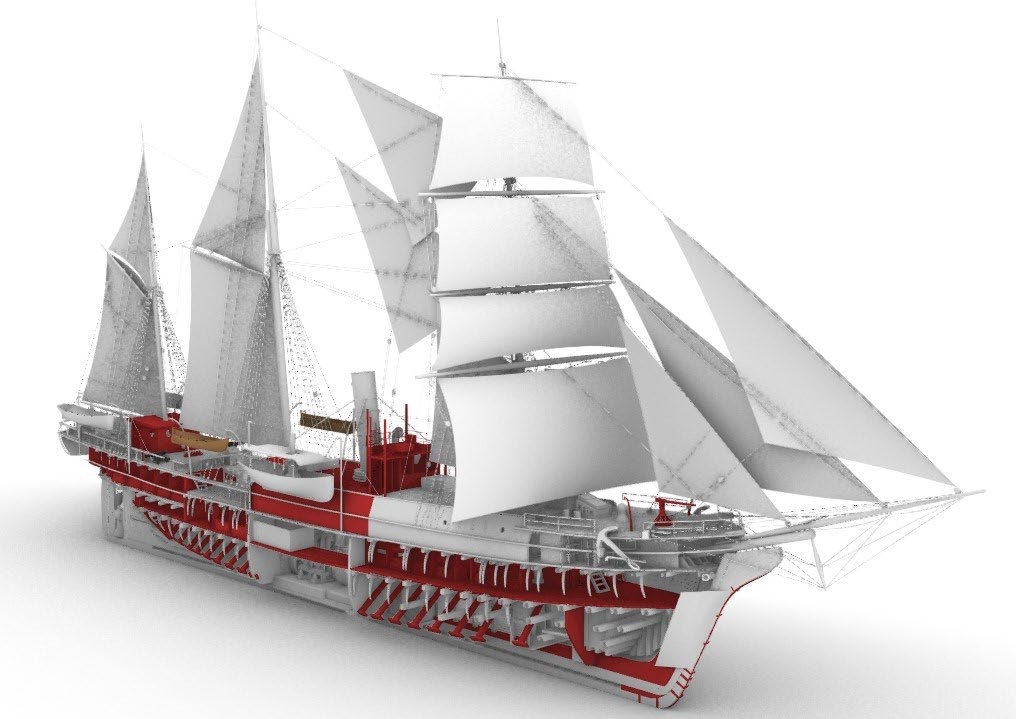 The Bear has often been referred to as “a ship of many lives.” Captain Healy’s Bear was a somewhat different ship from the one that was lost on its way to Philadelphia. She had been extensively refit for the Byrd Antarctic Expeditions, updating and installing more up-to-date equipment including a diesel engine and drivetrain, and many more modifications to support these far-flung expeditions. When she was pressed into service for World War II, she was similarly refit for this particular mission. While extensive archival research was conducted to better understand the scope and extent of these modifications, few details were revealed. So, what was being searched for was unquestionably the Bear, but what would be found might be challenging to identify.
The Bear has often been referred to as “a ship of many lives.” Captain Healy’s Bear was a somewhat different ship from the one that was lost on its way to Philadelphia. She had been extensively refit for the Byrd Antarctic Expeditions, updating and installing more up-to-date equipment including a diesel engine and drivetrain, and many more modifications to support these far-flung expeditions. When she was pressed into service for World War II, she was similarly refit for this particular mission. While extensive archival research was conducted to better understand the scope and extent of these modifications, few details were revealed. So, what was being searched for was unquestionably the Bear, but what would be found might be challenging to identify.
Finding a shipwreck is like solving any mystery. Collecting the best available information regarding the loss of the vessel, particularly its location when it was lost, is obviously an essential first step. A number of “last known locations” have been identified, and some excellent modelling, conducted by the USCG Research and Development Center employing the Search and Rescue Optimal Planning System (SAROPS) application, was available. Based on these, and other published speculations regarding where the Bear might be, seabed mapping target areas were identified.
 In 2019, the USCGC Bear (namesake of Captain Healy’s cutter) set off to sea to map these target areas. While the capabilities of the usual medium-endurance cutter are extensive, and the missions it routinely supports are similarly broad and varied, serving as a seabed mapping platform was not one of these. However, the highly capable and inventive engineers aboard were quickly able to fit the cutter with a very functional frame to support the side scan sonar cable running from the oceanographic winch brought aboard for the mission. Dry lab space was found near the deck where the winch and frame were situated, and the computer equipment installed to operate the Klein 3000 and 3900 side scan sonar systems to be deployed to collect the seabed mapping data. Once on station, the USCGC Bear helmsmen began the somewhat tedious task of mapping - “mowing the grass” - demonstrating great skill in assiduously following the tracks laid out to provide coverage of the target areas previously identified. Despite the passage of hurricanes offshore and the inevitable equipment malfunctions, over the more than 20 days on station, around 62 nautical square miles of area containing these “high-probability targets” was mapped. Few interesting features were imaged during most of the mapping mission - the seabed being largely flat sand - until the final day, when what was clearly a shipwreck, of about the same length and beam of the Mike Healy’s Bear, was identified. A final pass across this target, with the side scan sonar operating at higher resolution, produced a most intriguing image, located near one of the identified “last known locations.”
In 2019, the USCGC Bear (namesake of Captain Healy’s cutter) set off to sea to map these target areas. While the capabilities of the usual medium-endurance cutter are extensive, and the missions it routinely supports are similarly broad and varied, serving as a seabed mapping platform was not one of these. However, the highly capable and inventive engineers aboard were quickly able to fit the cutter with a very functional frame to support the side scan sonar cable running from the oceanographic winch brought aboard for the mission. Dry lab space was found near the deck where the winch and frame were situated, and the computer equipment installed to operate the Klein 3000 and 3900 side scan sonar systems to be deployed to collect the seabed mapping data. Once on station, the USCGC Bear helmsmen began the somewhat tedious task of mapping - “mowing the grass” - demonstrating great skill in assiduously following the tracks laid out to provide coverage of the target areas previously identified. Despite the passage of hurricanes offshore and the inevitable equipment malfunctions, over the more than 20 days on station, around 62 nautical square miles of area containing these “high-probability targets” was mapped. Few interesting features were imaged during most of the mapping mission - the seabed being largely flat sand - until the final day, when what was clearly a shipwreck, of about the same length and beam of the Mike Healy’s Bear, was identified. A final pass across this target, with the side scan sonar operating at higher resolution, produced a most intriguing image, located near one of the identified “last known locations.”
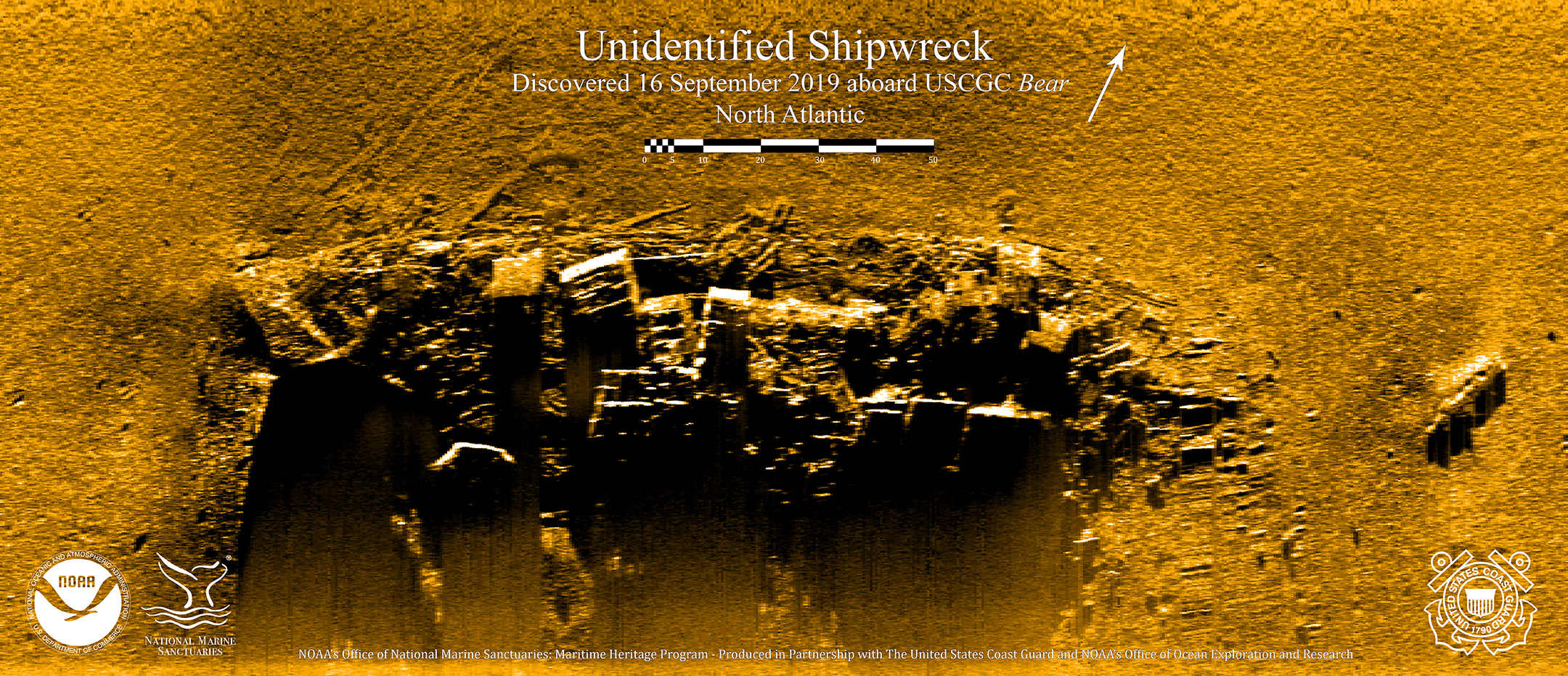 |
This image created sufficient interest and enthusiasm for NOAA’s Office for Exploration and Research, who had supported the 2019 seabed mapping mission, to offer supplemental funding to return to the “unidentified wreck” to document the site using a remotely operated vehicle (ROV). Despite some irritating delays due to the COVID pandemic, in 2021 the second phase of this mission was to be conducted aboard the USCGC Sycamore, a very capable ocean-going USCG buoy tender with a dynamic positioning (DP) system installed, which greatly facilitated the ROV operations. The USCGC Sycamore, like the USCGC Bear used for the seabed mapping mission, did not include research platform as part of its usual missions. However, with an experienced and able crew led by skilled officers (who routinely conducted launch and recovery operations of aids to navigation supported by the ship’s DP capability), the Sycamore easily and adeptly pivoted to rise to the challenge of supporting ROV operations.
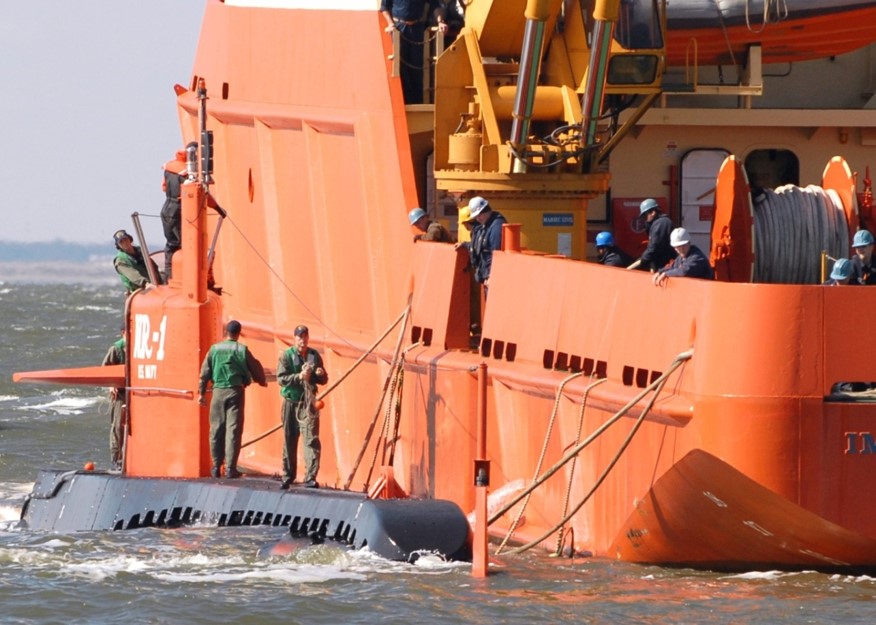 The ROV used for this mission was the Pixel, a highly advanced ROV with a suite of very high-resolution underwater cameras, developed and operated by Marine Imaging Technologies (MITech) of Woods Hole, Massachusetts. Both the ROV pilots and deck operations personnel were highly skilled and experienced imaging shipwrecks, having partnered with NOAA/ONMS previously on a number of similar projects. Once the equipment was loaded and installed aboard the Sycamore, she headed to sea with all hopeful that the unidentified wreck could be found again and imaged sufficiently to definitively identify it as the Bear.
The ROV used for this mission was the Pixel, a highly advanced ROV with a suite of very high-resolution underwater cameras, developed and operated by Marine Imaging Technologies (MITech) of Woods Hole, Massachusetts. Both the ROV pilots and deck operations personnel were highly skilled and experienced imaging shipwrecks, having partnered with NOAA/ONMS previously on a number of similar projects. Once the equipment was loaded and installed aboard the Sycamore, she headed to sea with all hopeful that the unidentified wreck could be found again and imaged sufficiently to definitively identify it as the Bear.
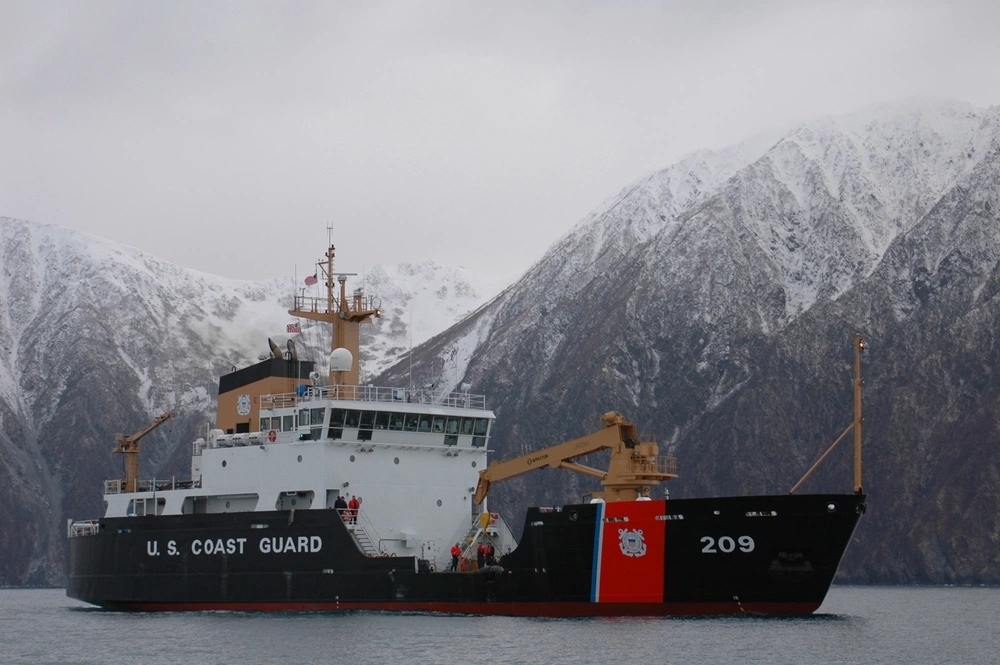 Arriving on station, the Sycamore had surprisingly little trouble finding the wreck with its single-beam echo sounder. At that point, the winds and seas were relatively calm, and the prospects for what was ahead appeared to be favorable. However, anyone who has conducted research at sea knows to anticipate the unexpected. After the Pixel was launched and found the seabed, it also found strong currents that varied over time and depth from different directions. As the ROV employed a down-weight that also provided high-intensity ambient lighting (what was called ‘the chandelier’), this variable and unexpectedly strong current regime made operations quite difficult. With the weather at the surface also intensifying, this was a very challenging situation, testing both the capabilities of the ship’s DP system, and the maneuvering capability of the ROV. Notwithstanding these challenges, the ROV operations proceeded, and while the anticipated systematic survey of the wreck could not be conducted, over about three days of dives the entire wreck was imaged multiple times before the increasingly problematic weather forced the Sycamore to return to port. More than 11 hours of high-resolution video was collected, as well as hundreds of photographs.
Arriving on station, the Sycamore had surprisingly little trouble finding the wreck with its single-beam echo sounder. At that point, the winds and seas were relatively calm, and the prospects for what was ahead appeared to be favorable. However, anyone who has conducted research at sea knows to anticipate the unexpected. After the Pixel was launched and found the seabed, it also found strong currents that varied over time and depth from different directions. As the ROV employed a down-weight that also provided high-intensity ambient lighting (what was called ‘the chandelier’), this variable and unexpectedly strong current regime made operations quite difficult. With the weather at the surface also intensifying, this was a very challenging situation, testing both the capabilities of the ship’s DP system, and the maneuvering capability of the ROV. Notwithstanding these challenges, the ROV operations proceeded, and while the anticipated systematic survey of the wreck could not be conducted, over about three days of dives the entire wreck was imaged multiple times before the increasingly problematic weather forced the Sycamore to return to port. More than 11 hours of high-resolution video was collected, as well as hundreds of photographs.
What was observed was a wreck that was highly disaggregated, with some of the stern section missing, but the bow relatively intact. It had been extensively damaged by mobile fishing gear, entangled throughout with nets, footropes, and roller/rockhopper gear. However, enough of the wreck was there, and many diagnostic features were identified potentially sufficient to identify the wreck. After the mission had concluded, video and images collected were intensively reviewed, and the potential diagnostic features were identified in a summary findings document.
This findings document, and the original images, and relevant archival research, was further evaluated by a team of maritime archaeologists and historians from the USCG and NOAA. While no absolutely definitive diagnostic features were identified, the extensive findings from the ROV survey offered some compelling evidence of the identity of the wreck. Based on this entire body of evidence, the evaluation team came to a consensus that they were “relatively certain” that the wreck was indeed the final resting place of the Revenue Cutter Bear. Supporting this finding were the location of the wreck, very close to the “last known position” and its general dimensions, as well as some particular diagnostic features.
Large metal staples were observed on the forefoot of the bow section, which precisely matched a historic photograph of the Bear from the assembled archival materials. A similar pattern of steel sheathing on the bow section was observed in this ROV documentation and historic photographs. A propeller post was imaged that appeared to have the same bolt pattern as shown in another historic photograph taken during the Byrd Expedition refit. Altogether, more than a dozen diagnostic features were evaluated, contributing to the identification.
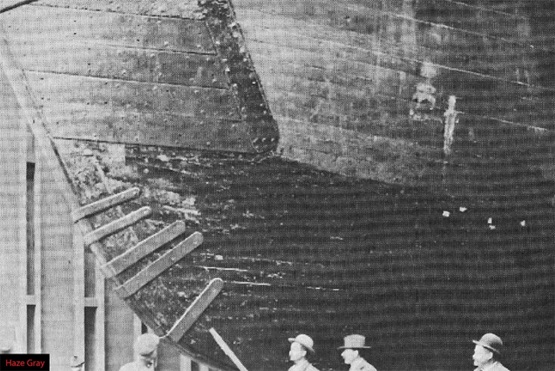 |
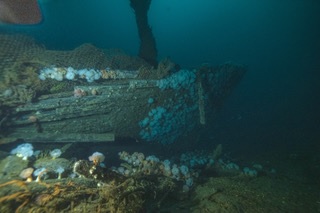 |
The U.S. Revenue Cutter Bear is, by any measure, a ship of some considerable significance in the maritime history and heritage of the United States. While the wreck of the Bear has been damaged over the years, it is a site that warrants and deserves some sort of protection. It is located in Canadian waters, and initial discussions have begun with the Canadian agencies that oversee their marine protected area (MPA) programs. Interestingly, the location of the wreck is within a proposed MPA being evaluated by the Department of Fisheries and Oceans under their Oceans Act authority. This MPA would not directly and explicitly protect the wreck for its historical significance but is likely to limit or prohibit mobile fishing gear use, which would remove or reduce the primary cause of damage to the wreck. It has also been suggested that perhaps Parks Canada and NOAA consider an international designation for a protected area around the wreck, but there are few, if any precedents for this sort of bilateral initiative related to submerged historic resources, and at this point, this is just an idea. The future story of the possible preservation of the final resting place of the ancient and honorable Bear remains to be written, but the identification offers another chapter in this long and most compelling story of Captain Healy’s Bear.
-USCG-